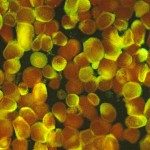Link to Pubmed [PMID] – 23653352
J. Biol. Chem. 2013 Jun;288(25):18561-73
Widespread drug resistance calls for the urgent development of new antimalarials that target novel steps in the life cycle of Plasmodium falciparum and Plasmodium vivax. The essential subtilisin-like serine protease SUB1 of Plasmodium merozoites plays a dual role in egress from and invasion into host erythrocytes. It belongs to a new generation of attractive drug targets against which specific potent inhibitors are actively searched. We characterize here the P. vivax SUB1 enzyme and show that it displays a typical auto-processing pattern and apical localization in P. vivax merozoites. To search for small PvSUB1 inhibitors, we took advantage of the similarity of SUB1 with bacterial subtilisins and generated P. vivax SUB1 three-dimensional models. The structure-based virtual screening of a large commercial chemical compounds library identified 306 virtual best hits, of which 37 were experimentally confirmed inhibitors and 5 had Ki values of <50 μM for PvSUB1. Interestingly, they belong to different chemical families. The most promising competitive inhibitor of PvSUB1 (compound 2) was equally active on PfSUB1 and displayed anti-P. falciparum and Plasmodium berghei activity in vitro and in vivo, respectively. Compound 2 inhibited the endogenous PfSUB1 as illustrated by the inhibited maturation of its natural substrate PfSERA5 and inhibited parasite egress and subsequent erythrocyte invasion. These data indicate that the strategy of in silico screening of three-dimensional models to select for virtual inhibitors combined with stringent biological validation successfully identified several inhibitors of the PvSUB1 enzyme. The most promising hit proved to be a potent cross-inhibitor of PlasmodiumSUB1, laying the groundwork for the development of a globally active small compound antimalarial.









